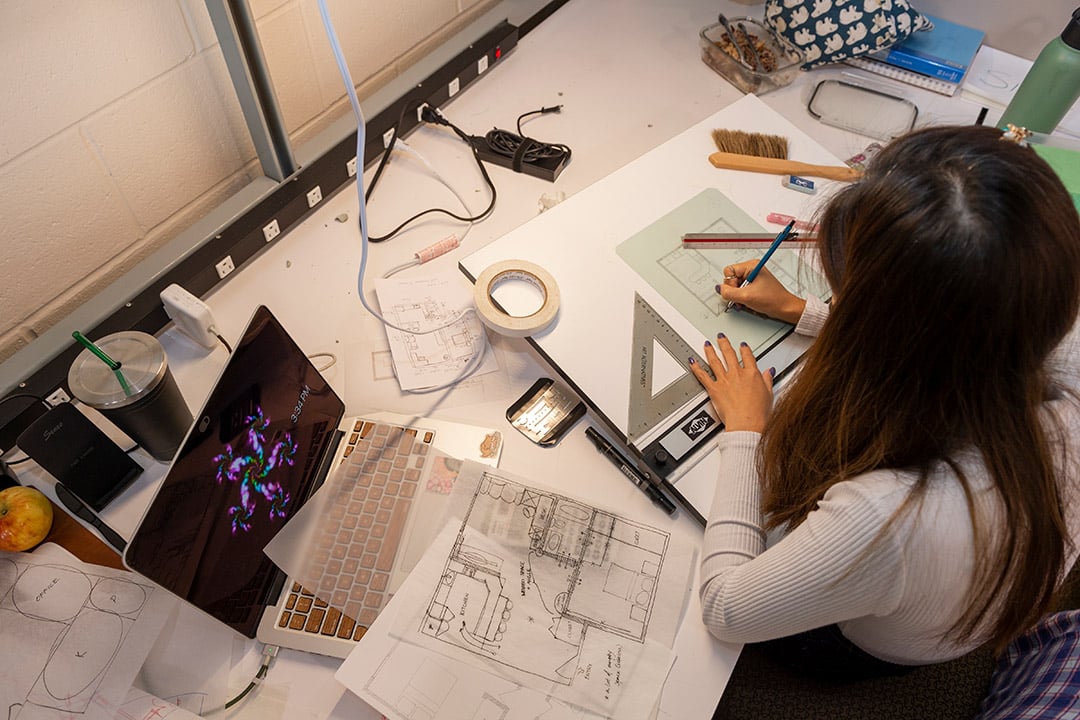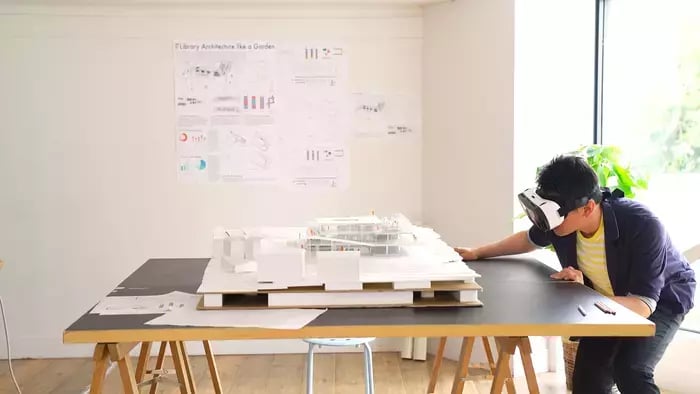Masters in Architecture: 8 Things to Consider Before You Enrol (2025)

Table of Contents
Soon after completing their undergraduate studies, many students naturally think about doing a master's degree in architecture.
But is a master’s in architecture worth it? It is a rather subjective question that is influenced by many factors. Choosing the right university, location, finances and career opportunities are just a few of these factors that prospects should consider before making a decision. And it goes without saying that you need to research and ask many other questions in order to find the answer.
In this blog, we will break down the questions you need to ask yourself if you are planning to pursue a master’s in architecture.

Prerequisites to Apply for Masters Architecture Degree
Before you commence your pursuit of applying for professional degree programs in architecture, here are some things to keep in mind.
- It is important to ensure to compile all required documents from your graduate school such as documents that support an accredited professional degree.
- If you are an international student, you must consider the school’s fees, rentals, travel, and other miscellaneous expenses.
- For the school you’re applying to, make sure you receive the course catalogue and read carefully through the required courses, types of architecture majors, and electives available.
- It is extremely important to check that your college (if you are applying to colleges in the United States of America) is registered with the National Architectural Accrediting Board.
- Check for any other requirements that the M.Arch program might require from your graduate school or architectural registration board in your admission form.
- As a prospective student, reach out to the robust student committees at your preferred college to discuss all M.Arch Program related queries and questions.

Benefits of Pursuing a Master’s Degree in Architecture
Pursuing a Master's Degree in Architecture or a similar industry-relevant upskilling course comes with multiple benefits including:
1. Research and Development Opportunities
With an industry-relevant curriculum and different types of architecture majors available, it allows students to explore new technologies and ideas. One can also yield opportunities to work with leading industry experts and develop research skills. Research and development (R&D) is a pronounced competency to acquire and can help you with a career in multiple fields.
2. Competitive Wages
With the right set of architectural skills, making a career in architecture can be fulfilling and rewarding. Upskilling through either a master's degree in Architecture or a similar industry-relevant course usually helps place the learner in the higher curve, leading to improved and usually a higher salary based on the skills of the architect and their experience in a particular role.
Read more: How to level up your Architecture Career with Computational Design
3. Professional Recognition
Many professional organisations and firms prefer a master's degree in Architecture or an equally competitive course for certification or any kind of membership. The organisations trust these degrees and courses to equip candidates with the skills of an architect at par with the industry standards. For architects, this opens up multiple opportunities for career growth and plays an eminent role when it comes to bagging an employment opportunity.
4. Multiple Career Opportunities
Upskilling through a master’s in architecture or industry-relevant courses opens up a lot of career opportunities in the industry. Having the skills needed for architecture, graduates can pursue work in government agencies, non-profit organisations, construction companies, and architecture firms, or even start their architecture practice.
5. Opportunities on a Global Scale
Masters in architecture and industry-relevant courses help architects and designers acquire architectural skills Upskilling through industry-relevant courses or Masters in architecture can help architects and designers to work and study abroad, collaborate, and work with professionals from other countries. This helps students to get valuable experiences and helps them map a global outlook on architecture.

8 Things to Consider Before Pursuing a Master's Degree in Architecture
While M.Arch programs, especially design studios intensive programs such as advanced architectural design, construction management, built environment, and urban design, might add value in terms of group engagements, studio workspace etc., architecture certificate courses are also a lucrative option that one could consider in order to achieve professional recognition and growth.
In today’s professional climate, such courses help architects and designers be aware of diverse software that is revolutionising the architecture, engineering and construction (AEC) industry. Concepts such as generative design, parametric design, building information modelling, and Algorithmic Design, to name a few.
Nonetheless, we try to answer some commonly asked questions by aspiring M. Arch students below.
1. Where are you currently in your career path and what is your future career plan?
Most architects pursue a master's degree in architecture for better job opportunities.
One common dilemma by all architectural graduates is about the post-graduation plans – should I start working or go for an architecture master's? If you have just graduated with a bachelor’s degree and starting an architecture career, it is not advisable to continue straight to a master’s in architecture. This is not to say it is not allowed, many have done it actually. But as a fresh graduate, the work experience you will gain in the first few years of your career is very valuable. You will pick up skills that can only be learnt by working in the field. These years are also when you should decide if you want to continue in this profession. Having said that, you can always explore upskilling yourself through online courses. Not only would this be a good opportunity to understand your interests but these certifications can always be an added skill on your resume and help you stand out from other industry professionals.
If you already have a few years of experience, then you are more aware of how you will work and what skills you will need in the profession. Then the question you should ask is if your current and future roles need the knowledge and skills taught in the master’s degree in architecture or perhaps could be met with a similar course online.
2. What is the opportunity cost?

The opportunity cost here is basically the money you could be getting by working a job, instead of doing a full-time course. Now, most master’s in architecture courses are 2 years long. There are very few master’s options that take less than 2 years to complete and even fewer that allow you to earn while you study. Sure, part-time jobs are an option, but they are just an additional source to pay your living expenses and don’t make a significant difference in the bigger picture. Plus, given that these full-time master’s programs are project-intensive with short deadlines, you might find yourself struggling to make ends meet while completing college assignments along with an ongoing job. The longer the master’s degree in architecture (along with little to no scope of getting full-time earnings), the bigger the opportunity cost and this, in turn, takes longer for you to get your return on investment.
Here, again, there are multiple ways to approach the requirement. Post-pandemic, many colleges and institutes also introduced certificate programs to help learners expand their knowledge and skills while saving their time and costs.
3. Are fees reasonable and affordable for you?

It is universally accepted that architecture school is expensive. It is not only the tuition fees that you will have to pay, but also application fees (if applicable) and other expenses procured during the programme. Many students from developing countries end up going abroad, hoping for a better quality of education, and in the process, using up life savings and taking out loans.
And how much of a loan? Well, the total tuition fee for an M.Arch in the USA can range anywhere from $16,000 to $80,000, according to research conducted by AECC Global. In the UK, the total program fee can range from £9,000 to £47,000, as revealed through research by Upgrad. This translates to anywhere between ₹9L to 65L. And this is just the tuition fee! Whereas the true ‘cost’ of your master’s degree in architecture will include all the finances necessary for you to start and end your degree successfully before you can start earning. Application fees, relocation costs, living expenses, and other miscellaneous expenses, all make up the cost of a master’s degree in architecture. And mind you, it can be pretty hefty!
Most masters in architecture courses are full-time making it harder to even take up a part-time job. We all know how tough it is to study architecture, so most students can only opt to work short hours, either part-time or as freelancers. However, the earnings may hardly be enough to pay your living expenses. Therefore, planning your finances ahead should be part of the first steps of planning for a master’s degree in architecture, along with finding the right school.
4. What is the return on investment (ROI)?

While starting an architecture career, something to consider very closely is – “how much did you invest and how fast are you getting your returns?” In the case of a typical master’s program, you can only start earning well after you graduate. The pay ranges from $60,000 to $110,000 depending on your work experience and skill. However, in India, the average annual salary of an M.Arch graduate in India is just ₹6 lacs!
Your salary also depends on your specialisation. If you specialise in a field that has high demand and earning potential, you can expect a good return on investment. But even that would take at least a couple of years to start manifesting. You first have to repay your debts, and what you earn is not what you repay. Only a part of your earnings is used to repay loans.
So, in addition to your opportunity cost, the time it would take to start getting returns is also a valuable resource lost. When we count the average figures, it would take about 4-5 years before you can start earning debt-free!
It should also be said that if you are not planning to work as an architect or a designer, it is best you do not go for a master’s in architecture. Many industry professionals agree that a degree in architecture teaches so much more than architectural knowledge. But if you are not using most of those skills and knowledge, then why do a master’s degree in architecture in this discipline? You can either choose from other fields or go for shorter courses and certifications.
If you are an architectural graduate and interested in BIM, there are a number of BIM certification programmes to choose from before embarking on a career in BIM.
5. For how long will the skills that I acquire in my master’s stay relevant?

Once upon a time, the half-life of a skill used to be 30 years. But now, according to the World Economic Forum, the half-life of a skill has now dropped to 5 years. Meaning that any skills you possess currently will be half as valuable 5 years from now. And since technology is advancing at such a rapid pace, the half-life will likely continue to drop even below 5 years in the years to come. So consider this – you enrol into a master’s programme, study there for 2 years, and then when you graduate, your technical skills will start losing relevance and would only be half as valuable in just the next 3 years.
So, is there no better way to escape this cycle of debts, repayments and loss of skill value for you to thrive in your careers?
Well, here’s an alternative - upskilling courses! Several options are now available for professionals who want to upskill and master a field without having to quit their day jobs and take out huge loans.
Read more: How Coding Helps Architects | Top 7 Coding Languages to Learn
Upskilling, as the name suggests, is the practice of taking your existing skills to the next level - a one-up for your professional lives! Now you may think, “Why should I learn something new when I’ve already spent a considerable amount of time shaping my existing skill set?” Well, the answer is simple - the industry today demands individuals to adapt to its growing needs, and at a much faster pace! Your degree is a mere qualifier - and your additional, industry-relevant skills and capabilities dictate your employability.
With the current digital revolution gaining a fast pace in the AEC industry, firms are shifting from traditional work processes to technologically-led ones. In this era of digital age, professionals who have a quick grasp on software such as Building Information Modeling (BIM) and Computational Design (CD) that not only assist with design but also support engineering services along with streamlining work processes acquire an edge over professionals still dabbling with archaic methods of working.
According to a recent survey by the Economic Times, 67% of recruiters today emphasise skills and experience more than the background and educational qualifications of the potential candidates. Moreover, with the shelf life of a skill shortening year after year, organisations today are looking for people with holistic job skills that include creative problem-solving skills, a collaborative mindset and an ability to adapt and deal with ambiguity and complexity in workforces.
6. How will a master's degree impact my career prospects and advancement opportunities?
A master's in architecture can significantly boost your career prospects by opening up more senior-level roles like lead architect, senior project manager, and urban designer, as well as opportunities with prestigious firms. Many top firms and architects actually have graduate degrees themselves.
The advanced skills, specialized knowledge and research/critical thinking abilities gained through the master's curriculum can better position you for management and leadership roles down the line. It demonstrates your commitment to continuous learning and mastery of your craft.
Some architecture career paths, like teaching at universities or getting licensed, also require a master's degree. So, if those are goals, a master's becomes essential rather than optional.
7. Besides academics, what other benefits does a graduate program provide?
Beyond just academics, a master's program can provide invaluable experiential benefits that assist your professional growth:
- Studio culture promotes peer collaboration, critique and feedback - crucial for architects.
- Access to state-of-the-art technology, fabrication labs and other resources.
- Opportunities to enter design competitions.
- Network with faculty who are renowned practitioners.
- Potential for internships/apprenticeships with connected firms.
- Build an advanced, competitive portfolio showcasing your design prowess.
These immersive experiences, connections, and portfolio pieces can be vital for getting hired by top firms post-graduation.
8. How can I fund my master's degree and manage costs reasonably?
With the high tuition and living costs, funding is a critical consideration. Some options to explore:
- Research institutional scholarships, grants, and assistantships - many exist specifically for graduate students.
- Look into low-interest student loans and education financing plans.
- See if your employer offers tuition assistance if studies relate to your role.
- Attend an in-state public university for much lower tuition fees.
- Consider lower cost-of-living cities/towns for housing savings.
- Explore accelerated 1-year master's programs to reduce overall outlay.
Many students work part-time jobs or internships concurrently. Cost-sharing among families can also help dilute the burden.
The key is to plan ahead, explore all available funding sources, and manage living costs frugally through location and time-frame choices.
Conclusion
Pursuing a master's degree in architecture is rather subjective and can be influenced by multiple factors. Beyond all reasons, time and monetary resources are two of the most important investments that you might perhaps need to evaluate before making the big decision. Make sure to consider all these prospects before finalising an option. Technology has not only accelerated the architecture, engineering and construction (AEC) industry into the next gear but also how one can look at education and acquire new skill sets and information to build an impressive career for themselves. To continue upskilling yourself, you can opt for shorter courses and certifications rather than enrolling in a university.
Novatr offers a professional course to expedite your learning journey. Using the best of resources and international mentors enables professionals to lead with an understanding of complex designs. Check out Novatr's Master Computational Design Course for Real-World Application and start upskilling today!
Need more guidance? Head to our free Resources Page.

 Thanks for connecting!
Thanks for connecting!


.png)




